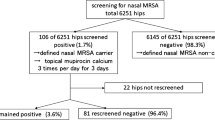Abstract
Surgical site infections (SSIs) with Staphylococcus aureus are a recognized adverse event of hip and knee replacements. We evaluated the impact of a program to detect S. aureus nasal carriers before surgery with preoperative decolonization (using mupirocin twice daily for 5 days prior to surgery) of carriers. Nasal swab samples were obtained from patients prior to surgery from 8/1/2003 through 2/28/2005. Samples were tested using real-time PCR technology to detect S. aureus. The group that developed S. aureus SSI was compared to a combined concurrent and historical control for one year following the operation. S. aureus caused 71% of SSIs in the combined control groups. Of the 1495 surgical candidates evaluated, 912 (61.0%) were screened for S. aureus; 223 of those screened (24.5%) were positive and then decolonized with mupirocin. Among the 223 positive and decolonized patients, three (1.3%) developed a SSI. Among the 689 screen-negative patients, four (0.6%) developed SSIs for an overall rate of 0.77%. Among the 583 control patients who were not screened or decolonized, 10 (1.7%) developed S. aureus SSIs. SSIs from other organisms were 0.44% and 0.69%, respectively.
Level of Evidence: Level III, therapeutic study. See the Guidelines for Authors for a complete description of levels of evidence.

Similar content being viewed by others
References
Anderson DJ, Sexton DJ, Kanafani ZA, Auten G, Kaye KS. Severe surgical site infection in community hospitals: epidemiology, key procedures, and the changing prevalence of methicillin-resistant Staphylococcus aureus. Infect Control Hosp Epidemiol. 2007;28:1047–1053.
Bozic KJ, Ries MD. The impact of infection after total hip arthroplasty on hospital and surgeon resource utilization. J Bone Joint Surg Am. 2005;87:1746–1751.
Cimochowski GE, Harostock MD, Brown B, Bernardi M, Alonzo N, Coyle K. Intranasal mupirocin reduces sternal wound infection after open heart surgery in diabetics and nondiabetics. Ann Thorac Surg. 2001;71:1572–1579.
Horan TC, Gaynes RP. Surveillance of nosocomial infections. In: Mayhall GC, ed. Hospital Epidemiology and Infection Control. 3rd ed. Philadelphia, PA: Lippincott Williams and Wilkins; 2004:1659–1702.
Kallen AJ, Wilson CT, Larson RJ. Perioperative intranasal mupirocin for the prevention of surgical-site infections: systematic review of the literature and meta-analysis. Infect Control Hosp Epidemiol. 2005;26:916–922.
Kalmeijer MD, Coertjens H, van Nieuwland-Bollen PM, Bogaers-Hofman D, de Baere GA, Stuurman A, van Belkum A, Kluytmans JA. Surgical site infections in orthopedic surgery: The effect of mupirocin nasal ointment in a double-blind, randomized, placebo controlled study. Clin Infec Dis. 2002;35:353–358.
Kalmeijer MD, van Nieuwland-Bollen E, Bogaers-Hofman D, de Baere G, Kluytmans J. Nasal carriage of Staphylococcus aureus is a major risk factor for surgical site infections in orthopedic surgery. Infect Control Hosp Epidemiol. 2000; 21:319–323.
Kaye KS, Engemann JJ, Mozaffari E, Carmeli Y. Reference group choice and antibiotic resistance outcomes. Emerg Infect Dis. 2004;10:1125–1128.
Kluytmans JA, Mouton JW, VandenBergh MF, Manders MJ, Maat AP, Wagenvoort JH, Michel MF, Verbrugh HA. Reduction of surgical-site infections in cardiothoracic surgery by elimination of nasal carriage of Staphylococcus aureus. Infect Control Hosp Epidemiol. 1996;17:780–785.
Kluytmans JA, Wertheim HF. Nasal carriage of Staphylococcus aureus and prevention of nosocomial infections. Infection. 2005;33:3–8.
Kourbatova EV, Halvosa JS, King MD, Ray SM, White N, Blumberg HM. Emergence of community-associated methicillin-resistant Staphylococcus aureus USA 300 clone as a cause of health care-associated infections among patients with prosthetic joint infections. Am J Infect Control. 2005;33:385–391.
Nicholson MR, Huesman LA. Controlling the usage of intranasal mupirocin does impact the rate of Staphylococcus aureus deep sternal wound infections in cardiac surgery patients. Am J Infect Control. 2006;34:44–48.
Noskin GA, Rubin RJ, Schentag JJ, Kluytmans J, Hedblom EC, Jacobson C, Smulders M, Gemmen E, Bharmal M. Budget impact analysis of rapid screening for Staphylococcus aureus colonization among patients undergoing elective surgery in US hospitals. Infect Control Hosp Epidemiol. 2008;29:16–24.
Paule SM, Pasquariello AC, Hacek DM, Fisher AG, Thomson RB Jr, Kaul KL, Peterson LR. Direct detection of Staphylococcus aureus from adult and neonate nasal swab specimens using real-time polymerase chain reaction. J Molec Diag. 2004;6:191–196.
Perl TM, Cullen JJ, Wenzel RP, Zimmerman MB, Pfaller MA, Sheppard D, Twombley J, French PP, Herwaldt LA. Mupirocin and the risk of Staphylococcus aureus study team. Intranasal mupirocin to prevent postoperative Staphylococcus aureus infections. N Engl J Med. 2002;346:1871–1877.
Peterson LR, Hacek DM, Robicsek A. Case Study: A MRSA intervention at Evanston Northwestern Healthcare. Joint Comm J Qual Patient Safety. 2007;33:732–738.
VandenBergh MF, Kluytmans JA, van Hout BA, Maat AP, Seerden RJ, McDonnel J, Verbrugh HA. Cost-effectiveness of perioperative mupirocin nasal ointment in cardiothoracic surgery. Infect Control Hosp Epidemiol. 1996;17:786–792.
Wilcox MH, Hall J, Pike H, Templeton PA, Fawley WN, Parnell P, Verity P. Use of perioperative mupirocin to prevent methicillin-resistant Staphylococcus aureus (MRSA) orthopaedic surgical site infections. J Hosp Infect. 2003;54:196–201.
Author information
Authors and Affiliations
Corresponding author
Additional information
Each author certifies that he or she has no commercial associations (eg, consultancies, stock ownership, equity interest, patent/licensing arrangements, etc) that might pose a conflict of interest in connection with the submitted article.
Each author certifies that his or her institution has approved the human protocol for this investigation and that all investigations were conducted in conformity with ethical principles of research.
About this article
Cite this article
Hacek, D.M., Robb, W.J., Paule, S.M. et al. Staphylococcus aureus Nasal Decolonization in Joint Replacement Surgery Reduces Infection. Clin Orthop Relat Res 466, 1349–1355 (2008). https://doi.org/10.1007/s11999-008-0210-y
Received:
Accepted:
Published:
Issue Date:
DOI: https://doi.org/10.1007/s11999-008-0210-y




